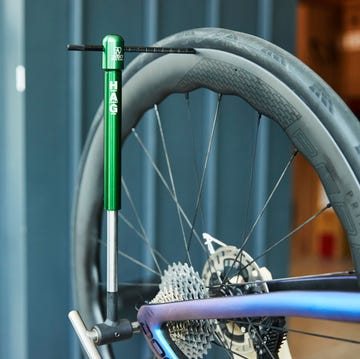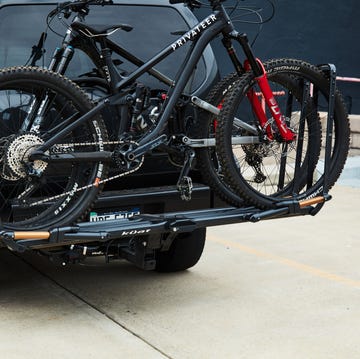In frame material lore, steel is romantic, titanium is magic, and carbon fiber is a super-material. Aluminum, meanwhile, is…what? While aluminum is widely used—from sub $100 balance bikes to $10,000 e-cargo bikes—it often gets cast in a negative light: It’s cheap, it’s harsh, it’s brittle, or it’s not durable. And that’s not fair, because aluminum is a miracle material that deserves some respect.
Even Richard Sachs—perhaps the most highly regarded living steel-frame builder in the world—is a fan of an aluminum frame. Sachs had an aluminum Gaulzetti Corsa—“had” because the frame was damaged when Sachs and an SUV came together in Asbury Park. The bike had large aluminum tubes, sloping top tube, BB30, integrated seat mast, carbon fork, and “one of those wacky LARGE headset thingies.” Even though it was entirely different than the bikes he builds, Sachs liked the Gaulzetti. And not because it was or wasn’t aluminum; Sachs liked it because it fit well and rode well. “It was so polar opposite than anything I make, yet the actual ride was a mirror image of what I make for myself. It was my riding position contact points melded with a rational frame design.” As far as how the Corsa rode compared to his bikes, Sachs says, “I couldn’t tell or feel any single differences.” That’s a statement likely to cause traditionalists’ jaws around the world to drop.
All frame materials have their good and bad points. But even among the common materials, aluminum is unique. It’s abundant and reasonably priced. When used properly it has a nice feel, and it has a blend of properties well-suited to bicycle frames. Aluminum frames have won everything from Tours de France to downhill World Championships.
At 1/3 the density of steel and about half the density of titanium, aluminum is a popular material in any application where weight is important. Aircraft—aluminum all day. The Saturn V rocket that took astronauts to the moon? Primarily aluminum. So, it’s only natural that cyclists—who have a teeny obsession with weight—would find it to be an attractive frame material as well.
While aluminum is light, weight is just one property, and aluminum’s other metallurgical properties require different design approaches than steel. You may be surprised to learn that early aluminum frames—Alan and Vitus for example—were flexible. That’s because aluminum is less stiff than titanium or steel, so when builders at the time took knowledge about tubing diameters from steel and substituted aluminum tubes, the resulting frames were soft.
Aluminum’s elongation (how far can it bend before it breaks) and endurance limit (how many times it can flex before it breaks) are also lower than those of titanium or steel. But aluminum’s low density helps it compensate for deficits in other properties. Because it’s less dense, you can use more of it to make up for its lower stiffness and strength without adding much weight.
The next big evolution came when Cannondale and Klein upped the tubing diameters well above steel standards. Aluminum frames became stiffer and stronger. This is when aluminum became famous for stiffness and infamous for a harsh ride feel.
Although it had a rough start, aluminum’s low weight—in combination with its relatively low cost and ease of use in manufacturing—was an irresistible pull. People kept experimenting with and improving aluminum frame design and technologies.
One of the names most associated with modern aluminum bicycle frames is Chuck Teixeira. Since 2011, he’s been Specialized's senior concept engineer; helping to develop products made of many materials, including the new Allez Sprint aluminum frame. Prior to Specialized, Teixeira spent 28 years at Easton—ultimately becoming director of engineering—specializing in aluminum products. His duties included product development, process development, and thermal development. It was Teixeira who developed the groundbreaking Easton ProGram and Taperwall aluminum tube sets, which, in their day, achieved new heights of weight, comfort, stiffness, and durability. He knows aluminum better than almost anyone else.
During our interview, Teixeira admitted, “Old opinions die hard,” regarding aluminum’s stereotyped drawbacks. We spent a lot of time discussing the importance of proper design, and how aluminum—more than titanium or steel—requires proper design and execution or it will “bite you in the ass.”
“It’s not only the material,” he said. “It’s a combination of the material and engineering, design, and techniques.” It is better design brought about by the accumulation of knowledge, along with technological advancements. As a result, today’s aluminum bikes have little in common with the original aluminum frames: “We understand the system better. We’re using more advanced techniques.”
The challenge to constructing a great aluminum frame, says Teixeira, comes down to the welds. In steel or titanium, the weld zones can be nearly as strong as the tubes themselves. But when you weld aluminum, you lose strength in that zone. “You lose a lot in there—you gotta engineer for that. That’s why you do butting, that’s why you do hydroforming, that’s why you do complex gussets and other techniques to shore that up,” he said.
Teixeira explained that aluminum’s low density provides designers with a lot of material with which to work. “You can move it around in the system. You have a weak spot, or a high-stress spot, and you can put a lot of material there. With titanium and steel, when you’re dealing with a density of two and three times that of aluminum, you don’t have that much to go around. You run out of material because the thing will get too heavy.”
More than other metals, aluminum benefitted from adopting butted, or variable wall thickness, tubing. This puts more material where it’s needed for strength but removes material where strength is less of a concern. Adopting butted tubes was a huge step forward for aluminum, not because it made aluminum frames lighter or stronger, but because it added more flex in less-stressed areas, which improved the ride. Another huge jump in aluminum’s performance came with the advent of hydroforming (using pressurized oil to create complex tube shapes). Hydroforming (combined with aluminum’s ease to machine) makes it second only to carbon in its ability to be shaped and tuned. That’s why aluminum frames can approach the performance and weight of carbon fiber, but at lower prices.
A frame’s head tube and bottom bracket have the biggest strength demands. So, in these areas, an aluminum frame needs to be stiff (to reduce flex that leads to fatigue failure) and overbuilt (due to the loss of strength after welding). But many other areas of the frame don’t have these requirements. “In the middle of the tube is where the magic and the science actually happen,” said Teixeira.
Of the old Kleins and Cannondales, Teixeira says, “[Those tubes] were reinforced, and harsh, and stiff and strong throughout. Multiply that by all seven tubes on the bike and all of sudden you have a losing combination. It may be light and strong enough, but it’s just harsh.” In contrast, today’s aluminum bikes only have that stiffness, strength, and reinforcement in the areas of the tube where it’s required, while the rest of the tube “can be flexible, it can be soft, it can be everything you want it to be because the strength and the stiffness is not as important,” he said.
The diversity of styles and prices also hurts the perception of aluminum. Because it is so ubiquitous, some view the material as cheap and not as high-tech. That—because it is used to make beer cans and $99 balance bikes—somehow it is a substandard material for a $3,300 Cannondale CAAD13. This perception apparently doesn’t stick to steel, even though that’s the material of choice when you want to build the lowest-quality bikes. But there are different aluminum alloys (and steels), different levels of engineering and craftspersonship, and more or less attention to detail.
All the work Teixeira and others did, and the resulting evolution and knowledge advancement paid off. Even lower-cost bikes reap the benefits of all the work put into improving aluminum: A $560 Giant Escape 3 has a butted-aluminum frame, something that once was an exotic tube set for the highest-performance bikes. Today’s aluminum frames are stronger and ride smoothly while maintaining low weights and high stiffness (the good kind of stiffness). It’s worth mentioning again that because aluminum is abundant, inexpensive, and easy to manipulate, today aluminum is the most common and the most diverse frame material—in both price and style of bike.
So I’m here to say quit picking on aluminum. Modern aluminum is underappreciated and does not get the respect it deserves. After researching it, considering it, and riding a ton of bikes, I believe aluminum is—from low end to high end, and from balance bikes to cargo bikes and everything in-between—the best material for bicycle frames.

A gear editor for his entire career, Matt’s journey to becoming a leading cycling tech journalist started in 1995, and he’s been at it ever since; likely riding more cycling equipment than anyone on the planet along the way. Previous to his time with Bicycling, Matt worked in bike shops as a service manager, mechanic, and sales person. Based in Durango, Colorado, he enjoys riding and testing any and all kinds of bikes, so you’re just as likely to see him on a road bike dressed in Lycra at a Tuesday night worlds ride as you are to find him dressed in a full face helmet and pads riding a bike park on an enduro bike. He doesn’t race often, but he’s game for anything; having entered road races, criteriums, trials competitions, dual slalom, downhill races, enduros, stage races, short track, time trials, and gran fondos. Next up on his to-do list: a multi day bikepacking trip, and an e-bike race.
















